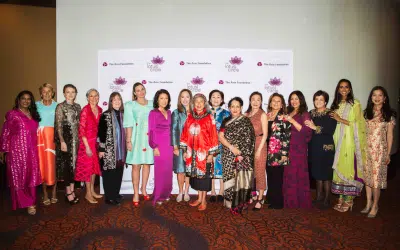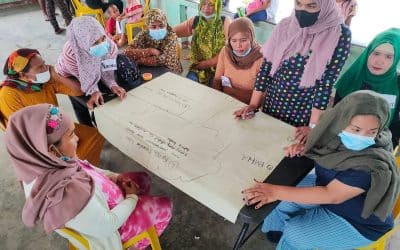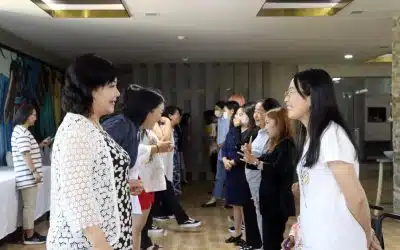InAsia
Insights and Analysis
A Long Road: Access to Justice in Laos
June 19, 2019
When her father died suddenly last year, the family of Mrs. Somleuthai (her name has been changed for privacy) started to break apart. Her father, a small farmer, had left an inheritance, 2.5 hectares of land in the rural district of Xayabouly. Her mother and each of her six siblings insisted that they had the rights to all of it. The fighting went on for over a year, family members stopped talking to each other, and some began to fear there would be violence.
As the fighting continued to escalate, the daughter attended a legal information session at a mobile legal aid clinic in the nearby village, where she learned about Laos’s inheritance law. The law says that in the absence of a will, her mother should get half the land, and she and her siblings should divide the other half equally. Armed with this legal opinion from an officer at the clinic, she was able to convince her family of their rights, and they agreed to follow the law. “We would still be fighting to this day,” she says, “if I hadn’t met the officer and learned that we now have a legal system that protects us.”

A legal aid officer consults with a villager during a mobile clinic.
“Rule of law” is one of the foundations of a free and just society, but in Laos, the formal state has had difficulty until recently bringing the full benefits of the justice system to large parts of the population that live in and around remote villages. Just a generation ago, most disputes were settled informally at the village level, but while village mediation remains an effective and even preferred way to resolve many local disputes, more formal mechanisms are sometimes necessary to protect individuals’ full rights under the law.
Almost 10 years ago, the Lao People’s Democratic Republic adopted the Master Plan on Development of the Rule of Law in Laos toward 2020. The Master Plan was meant to transform the rule of law in the Lao PDR by bringing formal legal aid and institutional support to vulnerable citizens living in remote areas across the forests and highlands of this largely rural nation.
But the story of Mrs. Somleuthai’s visit to the legal aid clinic starts much earlier, in 2007, when the Ministry of Justice, the Lao Bar Association (LBA), and The Asia Foundation embarked on a collaboration to develop a national system of legal aid. By 2011, they had shepherded three pilot clinics into existence—one in Oudomxay in the north, another in the nation’s central capital, Vientiane, and a third in Champasack in the south—run by the LBA and the Ministry of Justice, and with a budding program of legal aid officers made up of village volunteers. Ambition always outpaces progress, but over a decade of patient work, the Ministry of Justice established its own legal aid offices, five at the provincial level and two at the district level. By 2016, the government had adopted the Prime Minister Decision on Village Dispute Resolution Committees to formalize village mediation services and integrate local dispute resolution. Then, in 2018, the prime minister approved the Legal Aid Decree to expand legal aid offices across the country. Both laws had been under discussion since 2013.
While the laws were being written, the new legal aid offices were proving their worth, one case at a time. In an episode in 2010, a young girl was trafficked by a woman who promised her a high-paying job as her maid in Vientiane. When she arrived in the capital, she was met by a stranger and raped. There was no high-paying job. Eventually, the girl was able to open up to her family about her horrifying experience, and they sought help from an LBA legal aid clinic. Both the trafficker and the rapist were arrested.

A mobile clinic in the Kaenthao district of Xayabouly Province, the first Asia Foundation–supported legal aid office in Laos.
In 2017, another legal aid clinic, supported by the Law and Development Partnership (LDP), a pro-bono law firm, took on a garment factory that had closed and relocated without proper notice or severance pay to their employees. One hundred twenty-one factory workers turned to the legal aid clinic for help. They won their case and received LAK 800 million (about USD 92,000) in compensation from the factory owners.
Just last year, a woman in Vientiane was married to a Chinese man through a Lao marriage broker, with her family’s promise of a USD 2,500 dowry. But when she arrived in China, her “husband” handed her off to a woman who took her passport and locked her in a room. Before she could be trafficked further, she made a daring nighttime escape, jumping from a second-story window, flagging down a passing truck, and reporting her case to the Chinese police, who returned her to Laos. There, she turned to a legal aid clinic to sue the marriage broker, winning compensation and launching a criminal case.

A legal aid clinic in Pakse, in southern Laos.
Heading into the final year of the Master Plan, the Ministry of Justice will be considering stories like these as they plan for the future after 2020 and the push to extend the legal aid system to all 18 provinces and 148 districts. Many fundamental obstacles will have to be overcome before their vision reaches the far corners of the country, including finding the funds, the lawyers, and the legal aid officers to make the system work. But with tens of thousands of Lao citizens who have already received legal support from the eight legal aid clinics established as pilots, “rule of law” has taken on a tangible new significance in Laos. The next ten years will extend legal services even further, to the rural poor, the disabled, and the disadvantaged, helping to ensure that access to justice is universal.
Todd Wassel is The Asia Foundation’s country representative in Laos. He can be reached at [email protected]. The views and opinions expressed here are those of the author, not those of The Asia Foundation.
About our blog, InAsia
InAsia is posted and distributed every other Wednesday evening, Pacific Time. If you have any questions, please send an email to [email protected].
Contact
For questions about InAsia, or for our cross-post and re-use policy, please send an email to [email protected].The Asia Foundation
465 California St., 9th Floor
San Francisco, CA 94104
The Latest Across Asia
Program Snapshot
May 2, 2024
News
April 25, 2024

2024 Lotus Leadership Awards
The Lotus Leadership Awards recognize contributions towards gender equality in Asia and the Pacific







0 Comments